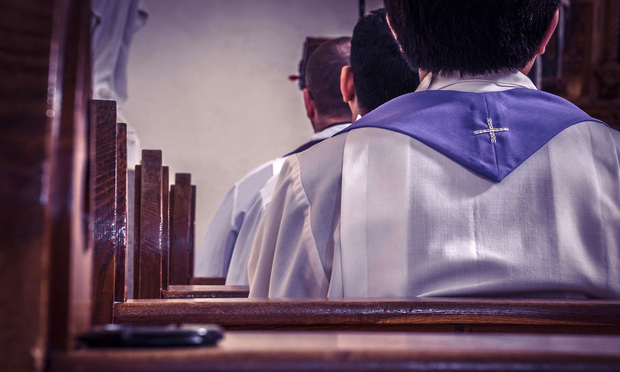Catholic Dioceses See Litigation Uptick in Wake of Grand Jury Sex-Abuse Report
A wave of lawsuits against Catholic dioceses has gained momentum in Pennsylvania courts and beyond in the wake of the explosive grand jury report on sexual abuse, and the state Senate's failure to create a window for survivors in the statute of limitations has not held it back.
December 03, 2018 at 05:36 PM
7 minute read
 Photo: Thoom/Shutterstock.com
Photo: Thoom/Shutterstock.com
A wave of lawsuits against Catholic dioceses has gained momentum in Pennsylvania courts and beyond in the wake of the explosive grand jury report on sexual abuse, and the state Senate's failure to create a window for survivors in the statute of limitations has not held it back.
The legislative effort, which had been mounted in the wake of a groundbreaking grand jury report outlining more than 70 years of abuse at numerous Catholic dioceses across the state, had garnered bipartisan support, and many survivors said they were hopeful that, after several failed attempts to open a litigation window for survivors, they would finally have their day in court. But the measure was bottled up in the state Senate.
The tide of litigation was not stemmed, however.
In the past few weeks, a dozen suits have been filed against the Roman Catholic Diocese of Pittsburgh, 20 suits were filed against a Connecticut diocese, two class action suits were filed in federal court against the United States Conference of Catholic Bishops, and many other individual actions have been filed against dioceses in Pennsylvania and across the country. The suburban Philadelphia law firm Hamburg, Rubin, Mullin, Maxwell & Lupin even set up a team of lawyers to focus on representing alleged victims.
Several attorneys who spoke with The Legal said they are seeing a renewed interest in sex abuse claims. The interest, they said, is fueled in large part by the grand jury report, as well as changing attitudes toward victims and newly uncovered evidence that might provide a broader basis for claims to circumvent the statute of limitations.
“We've gotten a lot of calls lately,” McLaughlin & Lauricella attorney Slade McLaughlin, who represented some of the victims of convicted child molester Jerry Sandusky, said. “Everybody's reading about what's going on.”
Attorney Michelle Simpson Tuegel of Hunt & Tuegel in Dallas, who represented victims of former Michigan State University doctor Larry Nassar, said that, after fielding numerous calls with survivors of clergy abuse, she and other attorneys she worked with previously realized they needed to “mobilize the team.”
Last month, her firm, along with attorney Gerald Williams of Williams Cedar in Philadelphia and Muhammad Aziz of Abraham, Watkins, Nichols, Sorrels, Agosto & Aziz in Houston, filed two lawsuits in Pennsylvania—one against the Diocese of Allentown, the other against the Diocese of Scranton. Both of the suits involve priests named in the grand jury report.
According to Tuegel, the report generated a lot of talk, sparked repressed memories in some cases, and eventually led survivors to seek legal counsel, in some cases even before they realized their abuse was detailed in the report.
“They did a lot of very detailed and important work in laying those pieces out,” she said, adding that discovering the facts of a victim's alleged abuse is as much of a driver for the lawsuits as any monetary compensation.
“We don't have all the facts,” she said. “But we will seek it through the lawsuit, through subpoenas and discovery, and that's something that's really important to our client.”
Both of those suits involve victims who are 29, so the statute of limitations should not be an issue. She said that, based on conversations with her clients and a detailed reading of the report, she expects more cases will be filed soon.
Kline & Specter attorney David Inscho, who filed three lawsuits in late November against the Archdiocese of Philadelphia, said changing attitudes toward victims and an increasing willingness on the part of victims to come forward have contributed to an uptick in litigation against the church generally.
“These victims are being empowered. They are being told they will be listened to, they will not be dismissed, which is what childhood sexual abuse teaches the victims—that their plights won't matter and they won't be believed,” Inscho said. “What these grand jury reports do is they empower the victims to be able to come forward.”
The lawsuits Inscho filed in late November deal with the sexual abuse of three preschoolers by their former lay teacher. The teacher previously pleaded guilty to abusing the children, and the suits raise negligent supervision and hiring claims.
Hurdles and Hope
The grand jury report that Pennsylvania's attorney general issued in August was one of the most comprehensive investigations into sex abuse within the Catholic Church. It outlined 70 years of abuse within six dioceses in Pennsylvania, and named 300 allegedly predatory priests, who were said to have abused thousands of children. The report caught widespread attention and spurred numerous similar probes nationwide.
However, in Pennsylvania, victims of childhood sexual abuse have until age 30 to file a civil complaint. With the abuse stretching back several decades, that means most of victims are barred from the courthouse under the statute of limitations.
But some attorneys are pushing forward with older claims anyway.
Pittsburgh attorney Alan Perer of Swensen & Perer said he recently filed more than 20 lawsuits against the Diocese of Pittsburgh, and is either in the process of, or has recently filed lawsuits, against other diocese in the state. Most of those claimants, he said, are in their 50s and 60s, so the statute of limitations will be a barrier. Perer, however, said he is using information uncovered in grand jury investigations to bolster fraudulent concealment and conspiracy claims, which he said he hopes will allow his clients to overcome the statute of limitations.
“In many of the cases I filed, the grand jury reported that the diocese had information on the priest at or about the time the victim was being assaulted, and they concealed that information. That would have been within the statute of limitations,” Perer said. ”In the past we alleged a lot of this. We alleged we believed the diocese had information about the abuse by priests and concealed it and moved the priests around. We alleged that, but the grand jury report is a game-changer because it actually went into the dioceses' secret files and got the evidence to back up the allegations.”
According to Perer, these fraudulent concealment theories have not yet been tested by the Pennsylvania Supreme Court, but they may be tested relatively soon as his lawsuit, Rice v. Diocese of Altoona-Johnstown, is set to be argued before a Superior Court panel Tuesday. That suit, he said, uses information uncovered by a similar grand jury investigation the Pennsylvania attorney general released in early 2016 to pursue fraudulent concealment claims.
“I am very encouraged by the public response to the disclosures that the grand jury came out with. In the early days, I found a lot of resistance,” Perer said. “The mood is different now. … I'm very encouraged by what's going on lately.”
In a statement to the press, Bill Genello, a spokesman for the Diocese of Scranton, said the diocese adheres to a zero tolerance policy regarding alleged abuse, and the diocese recently announced a compensation program for survivors.
“Bishop [Joseph] Bambera will continue to do all that he can to ensure our children are safe from abuse moving forward, and will address allegations swiftly and transparently, as he has always done,” the statement said. “The Diocese of Scranton supports all victims of abuse as they bring forward allegations against members of the clergy.”
A spokesman for the Archdiocese of Philadelphia declined to comment about pending litigation. The Diocese of Allentown also declined to comment for the story.
The Diocese of Pittsburgh and the U.S. Conference of Bishops each did not return a message seeking comment.
NOT FOR REPRINT
© 2025 ALM Global, LLC, All Rights Reserved. Request academic re-use from www.copyright.com. All other uses, submit a request to [email protected]. For more information visit Asset & Logo Licensing.
You Might Like
View All


Stevens & Lee Hires Ex-Middle District of Pennsylvania U.S. Attorney as White-Collar Co-Chair
3 minute read
Judge Tanks Prevailing Pittsburgh Attorneys' $2.45M Fee Request to $250K
5 minute readTrending Stories
- 1Decision of the Day: Court Holds Accident with Post Driver Was 'Bizarre Occurrence,' Dismisses Action Brought Under Labor Law §240
- 2Judge Recommends Disbarment for Attorney Who Plotted to Hack Judge's Email, Phone
- 3Two Wilkinson Stekloff Associates Among Victims of DC Plane Crash
- 4Two More Victims Alleged in New Sean Combs Sex Trafficking Indictment
- 5Jackson Lewis Leaders Discuss Firm's Innovation Efforts, From Prompt-a-Thons to Gen AI Pilots
Who Got The Work
J. Brugh Lower of Gibbons has entered an appearance for industrial equipment supplier Devco Corporation in a pending trademark infringement lawsuit. The suit, accusing the defendant of selling knock-off Graco products, was filed Dec. 18 in New Jersey District Court by Rivkin Radler on behalf of Graco Inc. and Graco Minnesota. The case, assigned to U.S. District Judge Zahid N. Quraishi, is 3:24-cv-11294, Graco Inc. et al v. Devco Corporation.
Who Got The Work
Rebecca Maller-Stein and Kent A. Yalowitz of Arnold & Porter Kaye Scholer have entered their appearances for Hanaco Venture Capital and its executives, Lior Prosor and David Frankel, in a pending securities lawsuit. The action, filed on Dec. 24 in New York Southern District Court by Zell, Aron & Co. on behalf of Goldeneye Advisors, accuses the defendants of negligently and fraudulently managing the plaintiff's $1 million investment. The case, assigned to U.S. District Judge Vernon S. Broderick, is 1:24-cv-09918, Goldeneye Advisors, LLC v. Hanaco Venture Capital, Ltd. et al.
Who Got The Work
Attorneys from A&O Shearman has stepped in as defense counsel for Toronto-Dominion Bank and other defendants in a pending securities class action. The suit, filed Dec. 11 in New York Southern District Court by Bleichmar Fonti & Auld, accuses the defendants of concealing the bank's 'pervasive' deficiencies in regards to its compliance with the Bank Secrecy Act and the quality of its anti-money laundering controls. The case, assigned to U.S. District Judge Arun Subramanian, is 1:24-cv-09445, Gonzalez v. The Toronto-Dominion Bank et al.
Who Got The Work
Crown Castle International, a Pennsylvania company providing shared communications infrastructure, has turned to Luke D. Wolf of Gordon Rees Scully Mansukhani to fend off a pending breach-of-contract lawsuit. The court action, filed Nov. 25 in Michigan Eastern District Court by Hooper Hathaway PC on behalf of The Town Residences LLC, accuses Crown Castle of failing to transfer approximately $30,000 in utility payments from T-Mobile in breach of a roof-top lease and assignment agreement. The case, assigned to U.S. District Judge Susan K. Declercq, is 2:24-cv-13131, The Town Residences LLC v. T-Mobile US, Inc. et al.
Who Got The Work
Wilfred P. Coronato and Daniel M. Schwartz of McCarter & English have stepped in as defense counsel to Electrolux Home Products Inc. in a pending product liability lawsuit. The court action, filed Nov. 26 in New York Eastern District Court by Poulos Lopiccolo PC and Nagel Rice LLP on behalf of David Stern, alleges that the defendant's refrigerators’ drawers and shelving repeatedly break and fall apart within months after purchase. The case, assigned to U.S. District Judge Joan M. Azrack, is 2:24-cv-08204, Stern v. Electrolux Home Products, Inc.
Featured Firms
Law Offices of Gary Martin Hays & Associates, P.C.
(470) 294-1674
Law Offices of Mark E. Salomone
(857) 444-6468
Smith & Hassler
(713) 739-1250





